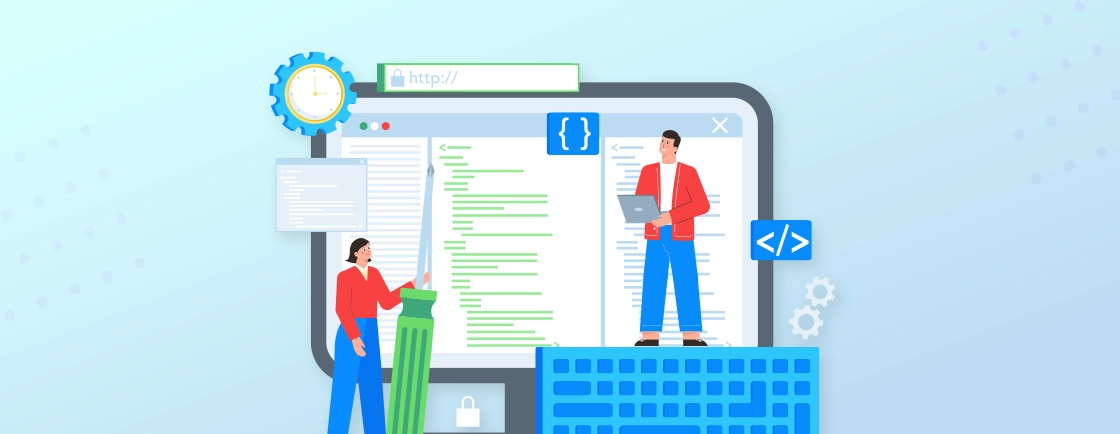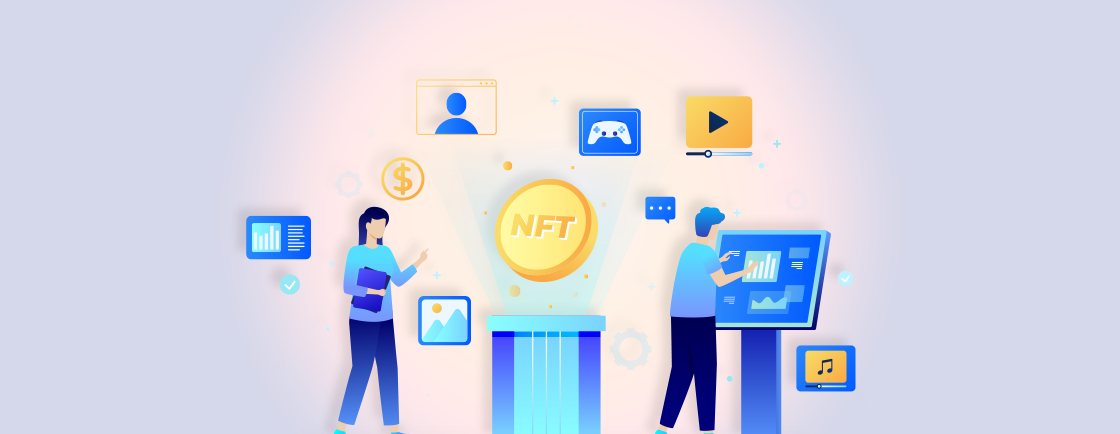Table of Contents
Since it was started in 1989, web development has come a long way. From simple static pages to dynamic, interactive applications, the web has transformed the way people interact with each other and present crucial information. So where does the future of web development lie? Well, it’s definitely marked by innovation, efficiency, and a focus on user experience.
With the emergence of cutting-edge technologies and evolving user expectations, our expert web developers strive to stay ahead of the curve for building the best sites and web apps. So our products are not only visually-stunning but also functional, accessible, and scalable.
Let’s discuss how web development is likely to evolve in the future.
Current Web Development Landscape
At present, over 250K websites are created every day, for everything from personal blogs to eStores, marketplaces, and social platforms. They are driven by technological advancements, changing user expectations, and the ever-growing demand for innovative digital experiences. Let’s look at the best practices involved.
Frontend Development
- JavaScript Frameworks: Angular, React, and Vue continue to dominate the frontend scene, offering robust tools for building complex and interactive web applications.
- Component-based Architecture: This approach promotes reusability and maintainability, making it easier to build scalable and modular applications.
- CSS Frameworks: Tailwind CSS, Bootstrap, and Material UI provide pre-built components and styles, accelerating development and ensuring consistency.
Backend Development
- Serverless Architecture: Platforms like AWS Lambda, Azure Functions, and Google Cloud Functions allow developers to build and run applications without managing servers. They can help reduce operational overhead.
- API-first Development: Designing and building APIs before the frontend ensures a clear separation of concerns and enables easier integration with other systems.
- Microservices Architecture: Breaking down applications into smaller, independent services improves scalability, resilience, and maintainability.
Full-Stack Development
- Full-Stack Frameworks: Frameworks like Next.js, Remix, and Nuxt.js offer a comprehensive set of tools for building both frontend and backend components.
- JAMStack: This architecture combines JavaScript, APIs, and Markup, enabling fast, statically generated websites with dynamic content.
Emerging Technologies
- Artificial Intelligence and Machine Learning: AI and ML are being integrated into web applications to provide personalized experiences, improve search results, and automate tasks.
- Progressive Web Apps (PWAs): PWAs offer a native-like experience on mobile devices, combining the best features of web and native apps.
- Headless CMS: These content management systems decouple the frontend from the backend, allowing for more flexibility and scalability.
Development Practices
- Agile Methodology: Agile web development practices, such as Scrum and Kanban, promote iterative development, flexibility, and collaboration.
- DevOps: DevOps aims to bridge the gap between development and operations teams, enabling faster deployment and continuous delivery.
- Accessibility: Ensuring that web applications are accessible to people with disabilities is becoming increasingly important. It’s driven by both legal requirements and ethical considerations.
Impact of IoT on Web Development
As more and more devices come into play with the internet, the demand for IoT-focused web applications has become increasingly popular. Here are some of the key impacts of IoT on web development:
Real-time Data Visualization and Analytics
IoT devices generate vast amounts of data that can be used to gain valuable insights. Web applications play a crucial role in visualizing this data in real-time, allowing users to monitor and analyze trends, identify patterns, and make data-driven decisions.
Remote Monitoring and Control
IoT-enabled devices can be remotely monitored and controlled through web applications. This enables users to manage their homes, businesses, and other assets from anywhere in the world. For example, smart home systems, industrial automation, and fleet management can all be controlled through web-based interfaces.
Integration with Other Systems
Web applications can serve as a central hub for integrating IoT devices with other systems, such as enterprise resource planning (ERP) software, customer relationship management (CRM) systems, and supply chain management (SCM) solutions. This enables seamless data flow and automation of processes.
Enhanced User Experience
IoT-powered web applications can provide a more personalized and engaging user experience. By leveraging data collected from IoT devices, developers can create tailored recommendations, optimize user interfaces, and deliver relevant content.
Security Challenges and Considerations
The increasing number of connected devices also introduces new security challenges. Web developers must implement robust security measures to protect IoT data and prevent unauthorized access. This includes encryption, authentication, and regular security updates.
Scalability and Performance
IoT applications often deal with large volumes of data and real-time requirements. Web developers must ensure that their applications are scalable and can handle the demands of a growing number of connected devices. Performance optimization techniques such as caching, content delivery networks (CDNs), and efficient database design are essential.
As the number of connected devices continues to grow, you will need to adapt to the challenges and opportunities presented by the IoT revolution.
Impact of AI & ML on Web Development
AI has got its mitts in every single industry today, so you can expect it being at the forefront of web development as well. With AI & ML, you can automate tasks, improve user experience, and get valuable insights as well. Our web development company also uses it to provide our clients with more intelligent, efficient, and personalized web applications.
Let’s look at the impact of AI/ML on web development.
Personalized User Experiences
AI and ML algorithms can analyze user data to understand their preferences, behaviors, and needs. This information can be used to personalize content, recommendations, and user interfaces, creating a more engaging and tailored experience.
Natural Language Processing (NLP)
NLP technology allows web applications to understand and respond to human language. This enables features such as chatbots, voice assistants, and intelligent search functionality.
Image and Video Recognition
AI-powered image and video recognition algorithms can be used to analyze visual content, identify objects, and extract relevant information. This has applications in areas such as eCommerce, social media, and content moderation.
Recommendation Systems
AI and ML can be used to develop sophisticated recommendation systems that suggest products, services, or content based on user preferences and behavior.
Automation
AI/ML can automate repetitive tasks, such as data entry, code generation, and testing, freeing up developers to focus on more complex and creative work.
Predictive Analytics
AI and ML algorithms can analyze historical data to predict future trends and outcomes. This can be used to optimize website performance, improve marketing campaigns, and identify potential risks.
Some of the best examples of AI in web development are chatbots, personalized product recommendations, image search, and predictive maintenance. For these features, there are some popular AI web development tools available. And if you need professional help, hire our web development experts.
Future Predictions in Web Development
Web industry is, anyway, going through quite a tumultuous time, where new revolutionary technologies arrive in the market every day. So predicting new tech would be a little tricky. But there are some existing techniques and strategies that are sure to pick up the pace and come at the forefront of nearly every project. Let’s look at a few of these.
Automated Web Design
Even now, there are a range of automated web design tools available; all you have to do is state your requirements and these tools will help create a custom website design. But as of now, these tools are limited in their capabilities.
However, in the near future, these tools are only going to get better and better, streamlining the website creation process. So businesses will be able to quickly and easily establish an online presence. This could lead to a surge in the number of websites and online businesses.
But if you need more personalized design and development for your website, our professional web design services will be more suitable.
Quantum Computing
Quantum computing has the potential to solve complex problems that are intractable for classical computers. This could have significant implications for web development, such as enabling faster rendering of complex graphics, more efficient search algorithms, and improved security protocols.
This advanced concept could lead to the development of entirely new types of web applications that are currently impossible. For example, it might enable the creation of highly realistic virtual worlds or the development of advanced AI systems for web development.
Motion UI
Motion UI involves adding movement and animation to web elements, creating more engaging and interactive user experiences. As designers and developers become more skilled at using motion UI, we can expect to see a proliferation of websites with dynamic and visually appealing animations.
This design tech can enhance user engagement and make websites more memorable. It can also be used to improve navigation and convey information more effectively.
Move to Serverless Architecture
Serverless architecture eliminates the need for developers to manage servers, allowing them to focus on building applications without worrying about infrastructure. This can lead to faster development cycles, reduced costs, and improved scalability.
It’s particularly well-suited for web applications that experience fluctuating traffic or require rapid scaling. This could make it a popular choice for startups, e-commerce platforms, and other web-based services.
Decentralized Technology
Decentralized technologies, such as blockchain and distributed ledgers, can provide a more secure, transparent, and resilient foundation for web applications. These technologies can be used to create decentralized marketplaces, social networks, and other platforms that are not controlled by a single entity.
This concept has the potential to disrupt traditional business models and create new opportunities for innovation. For example, blockchain can be used to create trustless transactions, while distributed ledgers can enable the creation of decentralized data storage and sharing platforms.
Metaverse & Web 3.0
Metaverse has been one of the most talked-about topics this decade so far. It’s a virtual world where users can interact with each other and digital objects in a 3D environment.
And Web 3.0, also known as the semantic web, aims to create a more interconnected and intelligent web by using semantic technologies. It makes information more accessible and understandable to machines.
These two trends are likely to converge, creating new opportunities for web development and user experiences. For example, we might be able to attend virtual meetings, shop in digital stores, and socialize with friends in immersive 3D environments. Web 3.0 could also enable the creation of more intelligent and personalized web experiences.
If you want to stay ahead of these trends for your business websites, it will be best to hire web developer. We carefully analyze the industry and come up with the best strategies to build excellent websites accordingly.
So, What’s the Future of Web Development?
To put it lightly, the future of web development is brimming with exciting possibilities. With the rise of new techniques and technologies, you can automate tasks, personalize experiences, and improve decision-making.
In terms of frontend development, expect to see further advancements in frameworks, CSS, and accessibility. And backend development, on the other hand, will be shaped by the evolution of databases, APIs, and serverless technologies. Plus there are new innovations like WebAssembly, the metaverse, and decentralized web development, which will offer new opportunities.
If you need help leveraging these techs and tactics for your business enterprise, consult with us.
FAQs on the Future of Web Development
How will blockchain technology impact web development?
Blockchain can enable decentralized applications (dApps) with enhanced security, transparency, and user control. However, its adoption in web development will depend on the specific use cases and challenges.
What will be the role of full-stack developers?
Full-stack developers will remain in high demand, but their focus will shift towards understanding and integrating various technologies. They’ll need to be proficient in frontend, backend, and DevOps practices.
What is the potential of WebAssembly?
WebAssembly has the potential to significantly improve web performance, especially for complex applications like games and video editing. It will also enable developers to reuse code written in languages like C++ and Rust.
Explore Our Expert Guides
Dive into detailed tutorials, tips, and strategies designed to help you grow, innovate, and solve problems efficiently.





